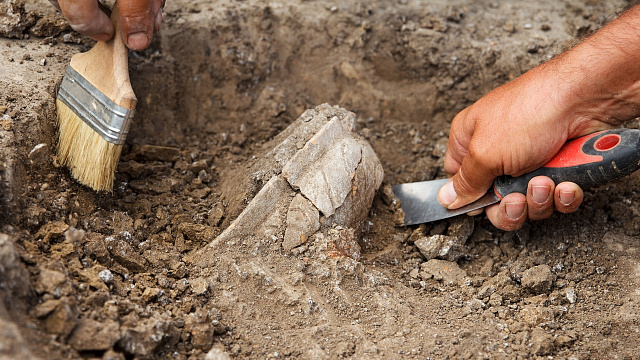In a remarkable archaeological breakthrough, researchers from the Centre for Archaeological Research of Novgorod State University have unearthed a ceramic pot estimated to be around 6000 years old in the vicinity of the Yuriev Monastery in Novgorod. This significant find sheds light on the late Neolithic era and contributes to our understanding of ancient cultures in the region.
The Significance of the Discovery
The ceramic pot, determined to have been crafted in the second half of the 4th millennium BC, represents a pivotal period in human history. The late Neolithic era was characterized by the development of agriculture, the establishment of permanent settlements, and advancements in craftsmanship. Such artifacts provide invaluable insights into the daily lives, artistic expressions, and technological capabilities of prehistoric communities.
Context and Location
The Yuriev Monastery, a historic landmark in Novgorod, is not only significant for its architectural and cultural heritage but also serves as a rich archaeological site. The recent discovery adds to the growing body of evidence indicating that the area was inhabited by early agrarian societies. The proximity of the monastery to such an ancient artifact reinforces Novgorod’s importance as a center of human activity throughout history.
Implications for Archaeological Research
The find has sparked excitement among archaeologists and historians alike, as it opens up avenues for further research into the late Neolithic period in Eastern Europe. The pot’s design, materials, and manufacturing techniques can provide clues about the social structure, trade networks, and environmental adaptations of the people who lived during that time.
Researchers are keen to analyze the ceramic’s composition to understand better the resources available to these ancient communities and how they might have interacted with their environment. The pot may also serve as a reference point for comparative studies with similar finds in other regions, enhancing our understanding of Neolithic cultures across Europe.
The discovery of the 6000-year-old ceramic pot near the Yuriev Monastery is a significant archaeological achievement that enriches our knowledge of early human civilization. As further studies are conducted, this artifact may reveal more about the lives of those who came before us, their innovations, and their connections to the land. Such discoveries remind us of the deep historical roots of our societies and the continuous quest for knowledge about our shared past.
The discovery of the 6000-year-old ceramic pot near the Yuriev Monastery not only highlights the archaeological significance of the site but also opens up a broader discussion about the Neolithic era and its impact on human development.
Understanding the Neolithic Era
The Neolithic period, often referred to as the “New Stone Age,” marks a crucial transition in human history. This era is characterized by the shift from nomadic lifestyles of hunting and gathering to settled agricultural communities. The late Neolithic, specifically during the 4th millennium BC, saw advancements in various aspects of life, including:
- Agriculture:
People began to cultivate crops and domesticate animals, leading to stable food sources and the growth of populations. - Settlements:
With agriculture allowing for a more sedentary lifestyle, communities began to establish permanent settlements, which laid the groundwork for future civilizations. - Craftsmanship:
The production of pottery became more sophisticated, with artisans creating vessels for storage, cooking, and ceremonial purposes. The ceramic pot discovered at Yuriev Monastery exemplifies this craftsmanship and provides insights into the technological advancements of the time. The Archaeological Context
Novgorod, one of Russia’s oldest cities, has a rich history that dates back over a thousand years. The area surrounding the Yuriev Monastery is particularly fertile for archaeological exploration. The discovery of the ceramic pot adds to a growing list of significant finds in the region, including tools, ornaments, and other pottery from various periods.
Archaeologists often use a method called stratigraphy to understand the chronological sequence of artifacts. By examining the layers of soil where the pot was found, researchers can piece together a timeline of human activity in the area. This method also helps identify how different cultures may have interacted over time.
Broader Implications of the Find
The implications of such discoveries extend beyond the local context. The ceramic pot can serve as a comparative artifact for researchers studying similar finds in Europe and beyond. By analyzing the styles, materials, and construction techniques, archaeologists can trace cultural exchanges and migrations that occurred during the Neolithic period.
Additionally, discoveries like this one often engage local communities and promote interest in heritage conservation. The pot’s unveiling can serve as a catalyst for educational programs, exhibitions, and discussions about the importance of preserving archaeological sites.
Future Research Directions
As further research is conducted on the ceramic pot and its surrounding context, several questions arise:
- What does the pot’s design reveal about the artistic expression of the time?
- Are there any signs of trade or interaction with neighboring cultures?
- What can the pot tell us about the dietary practices and cooking methods of the people who created it?
In conclusion, the discovery of the ceramic pot near the Yuriev Monastery is a gateway to exploring not only the specific cultural practices of late Neolithic societies but also the broader narrative of human development. As archaeologists continue their work, we can anticipate new findings that will deepen our understanding of our ancient ancestors and their contributions to the tapestry of human history.














I don’t think the title of your article matches the content lol. Just kidding, mainly because I had some doubts after reading the article.